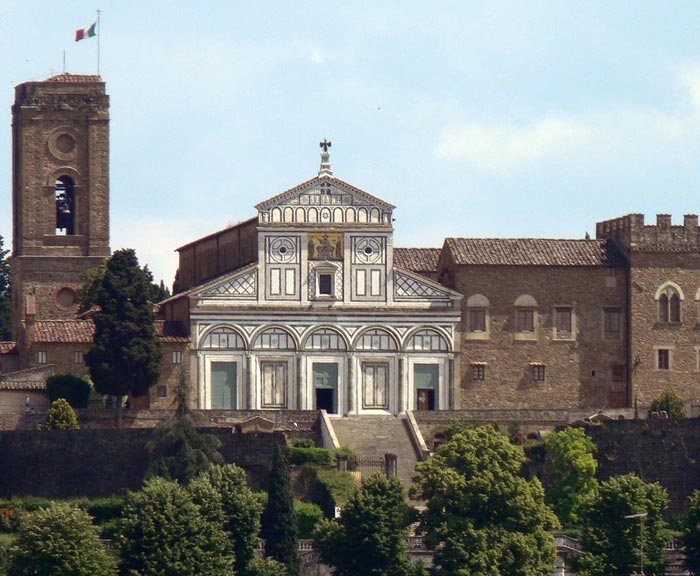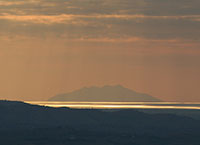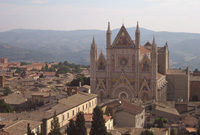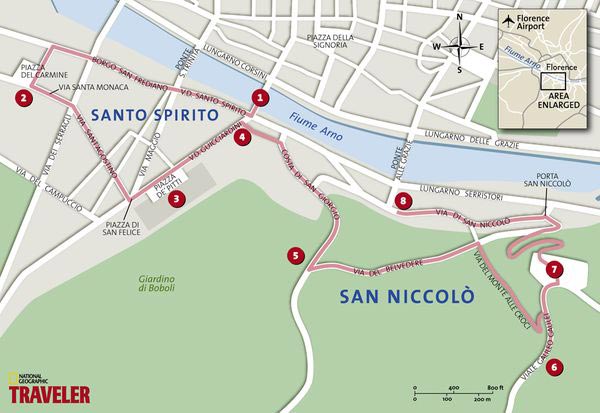| |
|
San Miniato al Monte, the upper facade
|
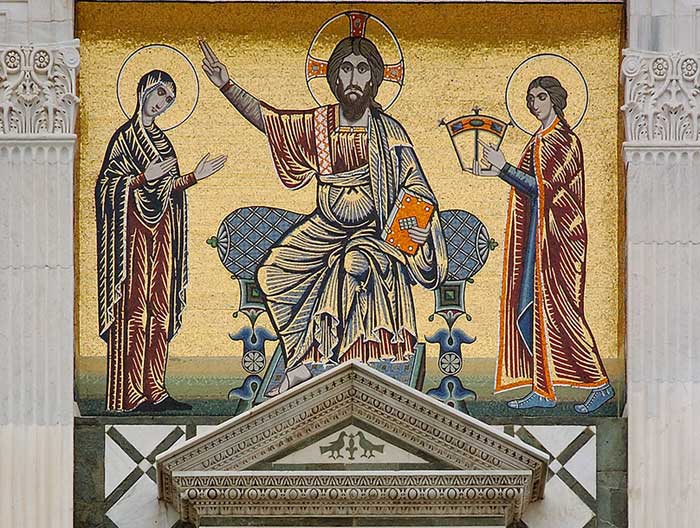 |
Central part of the upper facade (detail), showing the 13th c. mosaic, San Miniato al Monte, Florence [picture by Ron Reznick | www.digital-images.net]
|
San Miniato uses colored marble inlays on the facade, a feature that is characteristic of Florentine architecture. Unlike the decorative facades of some Florentine buildings, the arcades of the facade do not reflect the interior of the church--a basilical plan with two side aisles. The upper levels of the facade are later than the lower arcade. Here the ornamental paneling is almost overdone with decorative elements.
The geometrically patterned marble façade was probably begun in about 1090, although the upper parts date from the 12th century or later, financed by the Florentine Arte di Calimala (cloth merchants’ guild), who were responsible for the church’s upkeep from 1288. The eagle which crowns the façade was their symbol.
The mosaic depicting St. Miniato to the right of Christ holding a crown. The inscription reads: S. MINIATUS REX ERMINIE.
The mosaic of Christ between the Virgin and St Minias was made in 1260. The campanile collapsed in 1499 and was replaced in 1523, although it was never finished. During the siege of Florence in 1530 it was used as an artillery post by the defenders and Michelangelo had it wrapped in mattresses to protect it from enemy fire.
The interior exhibits the early feature of a choir raised on a platform above the large crypt. It has changed little since it was first built. The patterned pavement dates from 1207. The centre of the nave is dominated by the beautiful freestanding Cappella del Crocefisso (Chapel of the Crucifix), designed by Michelozzo in 1448. It originally housed the miraculous crucifix now in Santa Trìnita and is decorated with panels long thought to be painted by Agnolo Gaddi. The terracotta decoration of the vault is by Luca della Robbia.
The crypt is the oldest part of the church and the high altar supposedly contains the bones of St Minias himself (although there is evidence that these were removed to Metz before the church was even built). In the vaults are frescoes by Taddeo Gaddi.
|
|
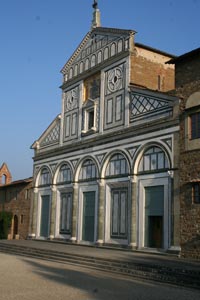 San Miniato al Monte, the upper facade
|
Chapel of the Cardinal of Portugal
|
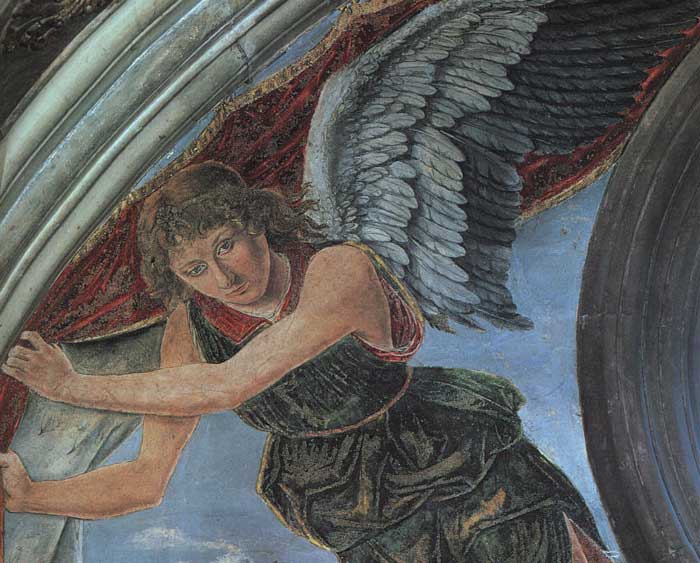 |
Antonio del Pollaiuolo, Angel (detail), 1467, fresco, San Miniato al Monte, Florence
This angel is on the altar wall of the Chapel of the Cardinal of Portugal.
|
The chapel was designed by Antonio Manetti, a pupil of Brunelleschi, and the architectural detail was carved by Giovanni Rossellino, third of the five Rossellino brothers. The tomb was designed by Antonio Rossellino, who was helped in the execution by his brother Bernardo, and several assistants. On the altar wall Antonio del Pollaiuolo's frescoed angels pull back curtains that can be related to the curtains that surround Rossellino's tomb on the right wall. The painted altarpiece representing three saints is a work by Antonio del Pollaiuolo (presently a copy, the original being in the Uffizi). On the left wall facing the tomb (not shown in this picture), Alesso Baldovinetti's Annunciation is placed. Baldovinetti decorated also the lunettes and spandrels of the chapel. The inlaid marble floor copies the Cosmati work found in the adjacent church; this pattern is echoed in the composition of Luca della Robbia's enamelled terracotta dome above, which has five medallions representing the Cardinal Virtues and the Descent of the Holy Ghost.
The Altarpiece of the Sts Vincent, James, and Eustace was executed between 1466 and 1468 for the chapel of the Cardinal of Portugal - Jacopo di Lusitania, dead in Florence in 1459 - in the church of San Miniato al Monte. Antonio del Pollaiuolo, in collaboration with his brother Piero, painted here the patron saints of the young cardinal, Vincent, James of Compostela and Eustace, enhancing more preciouseness and of clothes and jewels than sacred value of figures. The original frame, painted and gilded, is attributed to Giuliano da Maiano. The altarpiece has been in the chapel until 1880, when was transferred to the Uffizi and replaced by a copy. |
|
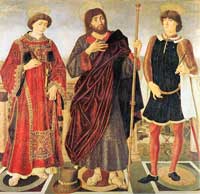
Antonio and Piero del Pollaiuolo, Altarpiece of the Saints Vincent, James and Eustace, 1468, tempera on panel, 172 x 179 cm, Florence, Galleria degli Uffizi |
|
|
|
San Miniato al Monte, raised choir and presbytery
|
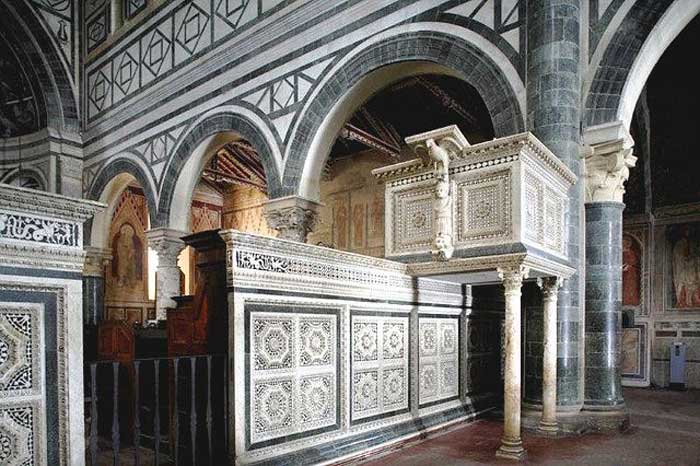 |
|
| |
The raised choir and presbytery contain a magnificent Romanesque pulpit and screen made in 1207. The apse is dominated by a great mosaic dating from 1297, which depicts the same subject as that on the façade and is probably by the same unknown artist. The crucifix above the high altar is attributed to Luca della Robbia. The sacristy is decorated with a great fresco cycle on the Life of St Benedict by Spinello Aretino (1387).
Returning to the entrance of the church, on the wall to the right is a fresco depicting The Madonna enthroned with the Child and Saints Francis, Mark, John the Baptist, John the Evangelist, James and Anthony Abbot, painted by Paolo Schiavo (1436). It is interesting to note how a painter of mediocre calibre effectively popularized Masaccio's plastic, powerful art in the first half of the 15th century.[3]
|
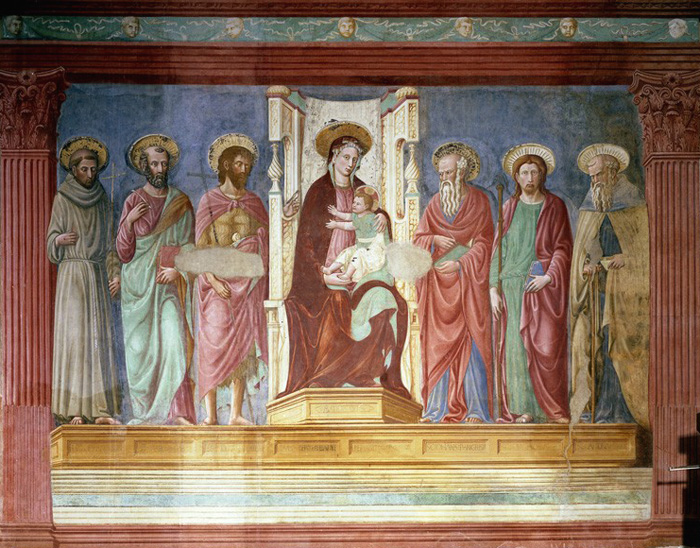 |
Paolo Schiavo, The Madonna enthroned with the Child and Saints Francis, Mark, John the Baptist, John the Evangelist, James and Anthony Abbot, fresco, San Miniato al Monte, Florence
|
On the right wall of the nave is a fresco by an unknown 14th-century artist depicting a giant St. Christopher typical of medieval iconography which frequently represented this legendary saint on a huge scale. There are also another two 15th-century pictures of St. James (reproduced here) and St. Anthony Abbot.
Sacred Doors Cemetery (Cimitero delle Porte Sante)
|
|
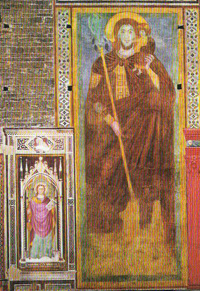 |
Adjacent to the church is the fine cloister, planned as early as 1426 and built from 1443 to mid-1450s. It was also designed by Bernardo and Antonio Rosselino, and financed by the Arte della Mercantia of Florence, and the fortified bishop’s palace, built in 1295 and later used as a barracks and a hospital. The whole complex is surrounded by defensive walls, originally built hastily by Michelangelo during the siege and in 1553 expanded into a true fortress (fortezza) by Cosimo I de' Medici. The walls now enclose a large cemetery, the Cimitero delle Porte Sante, laid out in 1854.
Carlo Collodi, creator of Pinocchio, politician Giovanni Spadolini, painter Pietro Annigoni, poet and author Luigi Ugolini, film producer Mario Cecchi Gori, sculptor Libero Andreotti, writer Giovanni Papini, and physicist Bruno Benedetto Rossi are buried there.
Pellegrino Artusi, writer, but best known as the author of the cookbook La scienza in cucina e l'arte di mangiar bene ("Science in the Kitchen and the Art of Eating Well") is buried in the Porte Sante cemetery.
|
|
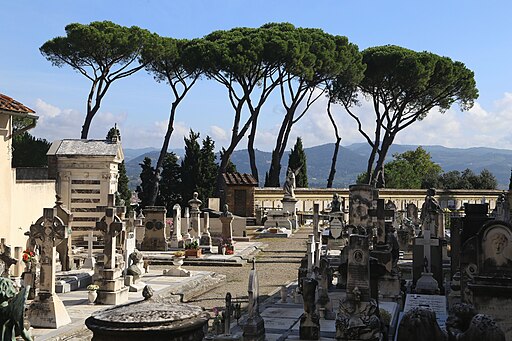 The Cemetery from the Basilica di San Miniato al Monte, Cimitero delle Porte Sante
|
| |
|
 |
Sacred Doors Cemetery (Cimitero delle Porte Sante) [4]
|
|
|
| |
|
Album immagini San Miniato al Monte
|
|
|
 |
|
 |
|
 |
San Miniato al Monte
|
|
San Miniato al Monte, Firenze, la facciata di San Miniato, uno dei capolavori dell'architettura romanica fiorentina
|
|
San Miniato al Monte, Firenze, la facciata con il mosaico di Cristo tra la Vergine e san Miniato, 1260 ca.
|
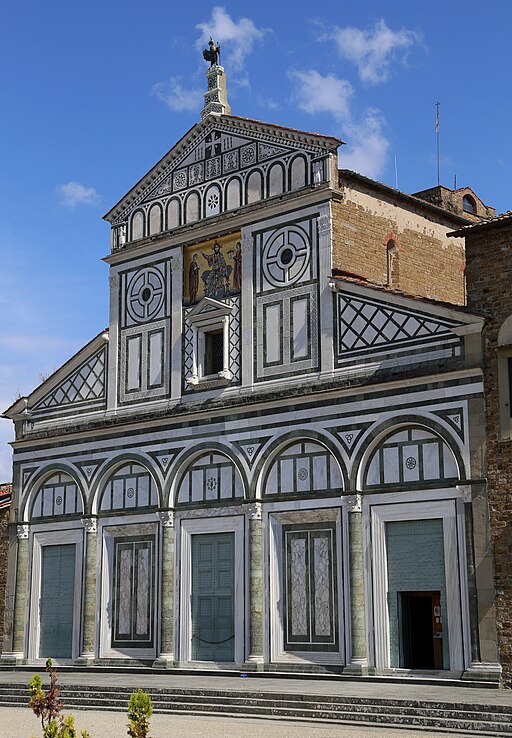 |
|
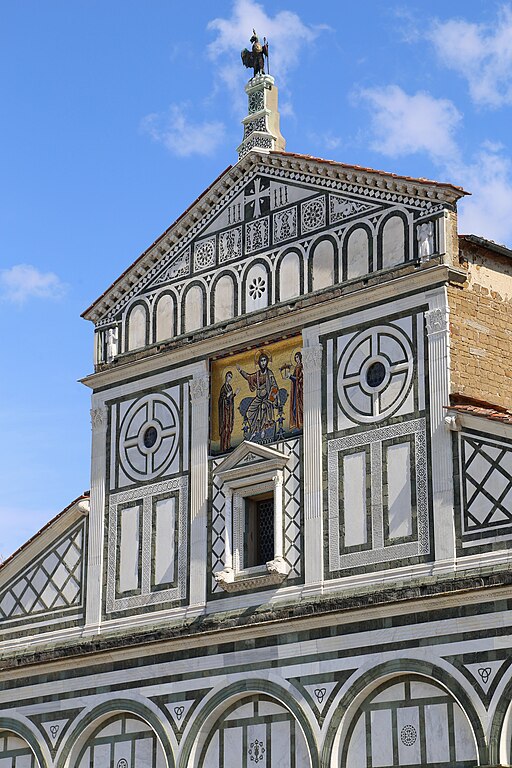 |
|
 |
San Miniato al Monte, la facciata con le due frontoni simmetrici delle navate
|
|
San Miniato al Monte, la facciata con le due frontoni simmetrici delle navate |
|
San Miniato al Monte, Cappella del Crocefisso |
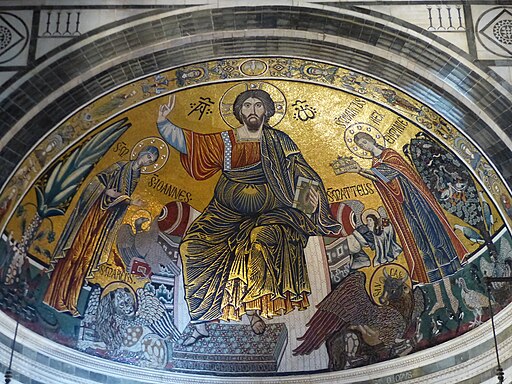 |
|
 |
|
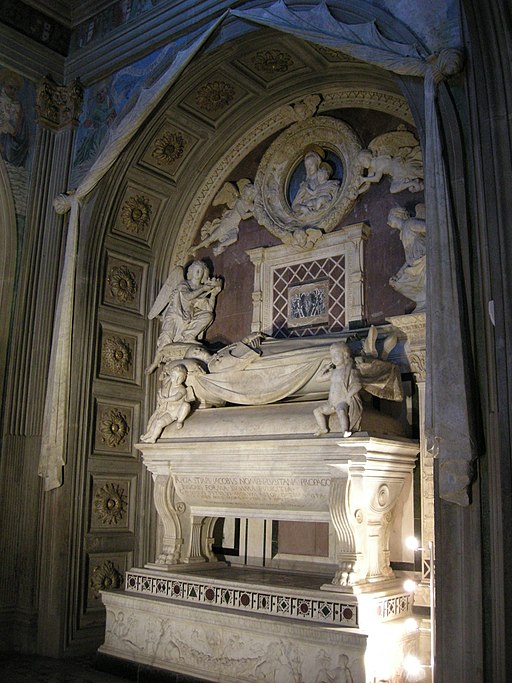
|
San Miniato al Monte, il mosaico in stile tardo bizantino (1297) dell'abside
|
|
Volta della cappella del Cardinale del Portogallo (1461-1466), San Miniato al Monte, Firenze
|
|
Cappella del cardinale di Portogallo, tomba del cardinale di Antonio e Barnardo Rossellino, San Miniato al Monte |

[1] St. Miniato or Minas was an Armenian prince serving in the Roman army under Emperor Decius. He was denounced as a Christian after becoming a hermit and was brought before the Emperor who was camped outside the gates of Florence. The Emperor ordered him to be thrown to beasts in the Amphitheatre where a panther was called upon him but refused to devour him. Beheaded in the presence of the Emperor, he is alleged to have picked up his head, crossed the Arno and walked up the hill of Mons Fiorentinus to his hermitage.[3] A shrine was later erected at this spot and there was a chapel there by the 8th century. Construction of the present church was begun in 1013 by Bishop Alibrando and it was endowed by the Emperor Henry II. The adjoining monastery began as a Benedictine community, then passed to the Cluniacs and then in 1373 to the Olivetans, who still run it. The monks make famous liqueurs, honey and tisanes, which they sell from a shop next to the church.
[2] Antonio Rossellino was a Florentine sculptor, brother of Bernardo Rosselino (1409-64). He was the youngest of five artist brothers, and his nickname (Rossellino means little readhead) became the name by which the whole family was known. Antonio was trained by his brother, and his most ambitious work - the tomb of the Cardinal Prince of Portugal in San Miniato al Monte, Florence (1461-66) - is based on Bernardo's Bruni tomb. It is more elaborate and concerned with movement than Bernardo's masterpiece, but also a less coherent design, and Antonio was a more distinguished artist when working on a smaller scale. His three panels (1473), carved in high relief, for the bishop's throne of Prato Cathedral are much admired, as is his statue Young Saint John the Baptist (c. 1470) in the National Gallery of Art, Washington.
He was a fine portraitist (Giovanni Chellini, Victoria and Albert Museum, London, 1456) and also made charming reliefs and statuettes of the Madonna and Child, in which he continued the tradition of Luca della Robbia of stressing the naturalness and humanity of the Virgin (perhaps the finest of his reliefs is that in the Metropolitan Museum, New York).
[3] Paolo Schiavo, was a famous painter in 15th century Florence. According to Vasari, Paolo Schiavo was a follower of Masolino. This is confirmed by those works securely attributable to him, though they date from a later phase of his activity. They include a signed and dated fresco of the Virgin and Child Enthroned with Saints (1436; Florence, S Miniato al Monte, see above), a fresco of the Crucifixion Adored by Nuns (1447- 8, Florence, convent of S Apollonia), also signed and dated; a panel of the Assumption (1460) and frescoes of the Adoration of the Magi, the Annunciation and various saints (all Quarto, nr Florence, S Maria Assunta). Other frescoes include Stories of St Stephen (c. 1436-40; Collegiata, Castiglione Olona), frescoes in the left-hand chapel of the church of S Michele a Castellaccio di Sommaia, near Florence, and a signed Virgin and Child with Saints (Monte San Michele, Greve in Chianti).
[4] Foto di Rufus46, licenziato in base ai termini della licenza Creative Commons Attribuzione-Condividi allo stesso modo 3.0 Unported
Bibliography
Damien Wigny, Au coeur de Florence : Itinéraires, monuments, lectures, 1990
|


One of the best places to slow travel in Tuscany is the Maremma, with its exquisite nature, small hillside villages, its epic countryside, cuisine and excellent wines. Podere Santa Pia is an ideal holiday house, perfect for relaxing and enjoying the splendor of the Maremma hills that rise up from southern Tuscany. Podere Santa Pia is a ninetieth century wonderful country house, located on the outskirts of Castiglioncello Bandini.
Tuscan Holiday houses | Podere Santa Pia
|
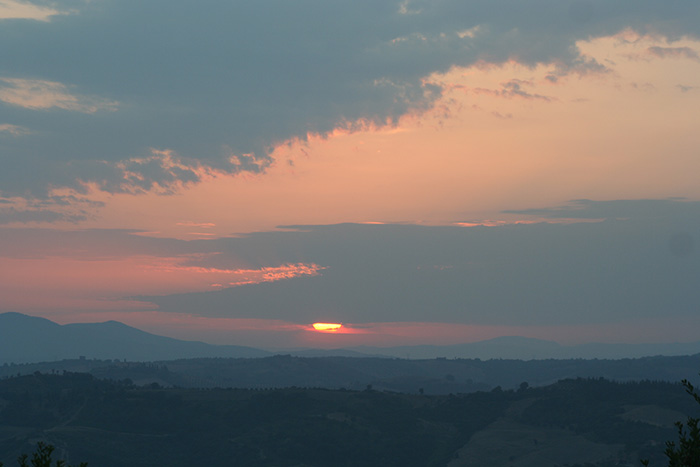 |
Podere Santa Pia, with a stunning view over the Maremma and Montecristo
|
| |
|
|
|
|
|
|
|
|
|
|
Podere Santa Pia |
|
Podere Santa Pia, garden |
|
Monte Christo, view from Santa Pia
|
| |
|
|
|
|
The ancient Via San Leonardo leads up out of the center of Florence on the south side of the Arno river and climbs up into the hills to the Arcetri district and the Pian dei Giullari where one finds the villa in which Galileo spent his last years.
Arcetri is a district of Florence, in the hills to the south of the city centre. A number of historic buildings are situated there, including the house of the famous scientist Galileo Galilei (called Villa il Gioiello), the Convent of San Matteo and the Torre del Gallo. The Osservatorio Astrofisico di Arcetri is also located here. The church of San Leonardo in Arcetri is the main church of the area.
The country house called "Il Gioello" or "The Jewel" because of its location on the crest of the hill of Pian dei Giullari. Pian dei Giullari or "The Field of the Minstrels" is located just up the hill from the monastery where Galileo's daughter lived. The villa is now being restored. The University of Florence has its department of Astronomy on the grounds including an observatory.
Gardens in Tuscany | Villa il Gioiello
Gardens in Tuscany | The Arcetri Hills and Villa La Gallina |
|
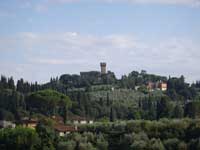 View of Arcetri area (in the hills above Florence) View of Arcetri area (in the hills above Florence)
|
| |
|
|
|
|
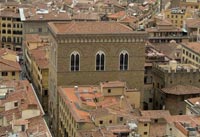 |
|
 |
|
|
Florence, Orsanmichele |
|
Florence, Duomo Santa Maria del Fiore |
San Miniato al Monte
Album immagini San Miniato al Monte
|
|
|
 |
|
 |
|
 |
San Miniato al Monte
|
|
La parte poste/engels/eng.htmriore di San Miniato al
Monte con Cimitero delle Porte Sante
|
|
San Miniato al Monte, storia del Cimitero delle Porte Sante |
| |
|
|
|
|
This article incorporates material from the Wikipedia article San Miniato al Monte published under the GNU Free Documentation License.
Wikimedia Commons has media related to: San Miniato al Monte. |

The Oltrarno and San Miniato
The Oltrarno — literally “across the Arno” — stands apart from Florence’s busy central and eastern quarters. Traditionally a blue-collar district, it retains a peaceful and workaday atmosphere, full of artisans’ studios, antiques stores, bars, and small restaurants. At the same time it features plenty of historic sights, not least the art-filled Palazzo Pitti and the church of San Miniato al Monte.
Originally, and up to the end of the 12th century, the urban territory of Florence was divided into quarters. When the city walls were enlarged between 1172 and 1175, the city had to be divided into six districts which also included the hamlets that had sprung up on the other side of the river, and which, with their many artisan activities, were to become a fundamental factor in the economic life of the city. These six districts included various peoples and groups and were then called Gonfaloni,
after the standards that identified the different districts and around which the inhabitants of the area gathered. In 1343 the Gonfaloni were reorganized since the city had grown considerably within the new circle of Arnolfo di Cambio's walls. The original six districts were replaced by a new subdivision into quartersnamed after the city's most important churches: San Giovanni, Santa Maria Novella, Santa Croce and Santo Spirito. The number of Gonfaloni was set at 16 and their functions gradually took on an administrative nature. The quarter of Santo Spirito was subdivided into 4 gonfalons: Drago, Ferza, Nicchio and Scala. Each gonfalon differed as to size, population and social fabric, but they were all characterized by spacious green areas within the 2 walls and by the prevalence of wool guild workers and craftsmen, especially in the Gonfalone of San Frediano Drago) and that of Santo Spirito (Ferza). Nowadays the Oltrarno is a living reality where the past is still alive in the "hum" of generations of craftsmen tenaciously attached to their ancient crafts. In the labyrinth of lanes in the Oltrarno one can still encounter artisans who preserve and hand down original and refined working methods, directly transmitted by the craftsmen who in past centuries enriched Florence with their handmade objects.
Start your walk at the (1) Ponte Vecchio, a picturesque bridge that dates from around 1345. Across the river, turn at the second right and follow Via di Santo Spirito and Borgo San Frediano to (2) Santa Maria del Carmine in Piazza del Carmine. The church is known for the Cappella Brancacci and Masaccio and Masolino’s pioneering early Renaissance frescoes (begun 1424).
|
From the east side of the piazza in front of the church take Via Santa Monaca and Via Sant’Agostino to Piazza di San Felice and Piazza de’ Pitti. The latter is home to the (3) Palazzo Pitti (www.palazzopitti.it), a vast former Medici palace that contains several galleries, including the standout Galleria Palatina.
A short distance away from the Pitti Palace, in the via Maggio, can be found the house of Bianco Cappello, which still retains its beautifully decorated facade. Bianca's house is, by far, the best example in Florence of a technique known as sgraffito, which was commonly used in the 16th century.
Walk north out of the piazza on Via de’ Guicciardini and visit the church of (4) Santa Felicita in Piazza di Santa Felicita. This is one of Florence’s oldest churches, built on the site of a fourth-century basilica. Inside, it contains paintings dating to the 1500s by Jacopo Pontormo, known for his vivid use of color and unsettling compositions. |
|
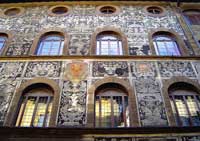
16th century sgraffito on Bianca Cappello's house
|
To the east and behind the church, take Costa di San Giorgio, a pretty lane that climbs steeply, with the former home of the scientist Galileo near the top at No. 19. Just beyond the house on the right at Via del Forte di San Giorgio is the entrance to the (5) Forte del Belvedere, a 16th-century fortress that formed part of the city’s outer defenses.
Turn left on Via del Belvedere, which follows part of the old city walls and offers lovely views to the Tuscan hills. At the bottom of the hill turn right on Via del Monte alle Croci.
At this point, Jonathan Buckley, co-author, The Rough Guide to Florence & Siena, recommends stopping for a drink and a breather at the wine bar-osteria Fuori Porta (Via del Monte alle Croci 10R; tel. 39 055 234 2483. www.fuoriporta.it).
Then turn almost immediately left up the stepped Via di San Salvatore al Monte. At Viale Galileo Galilei, turn right and walk up the steps to the 11th-century church of (6) San Miniato al Monte.
San Miniato is one of Tuscany’s finest Romanesque buildings. Highlights in the interior include the pulpit, screen, apse mosaic (from 1297), and the beautifully decorated Cappella del Cardinale del Portogallo.
You can catch a bus back to the city center from Viale Galileo Galilei or walk to (7) Piazzale Michelangelo just north of San Miniato. Enjoy the sweeping city views from the piazzale; then follow the path off its left (west) side down to Porta San Niccolò. Turn left here on Via di San Niccolò to the (8) Museo Bardini in Piazza de’ Mozzi, an unsung but enticing and eclectic collection of art and artifacts.
|
|
Extended Itinerary | Walking in Tuscany | Florence | San Niccolo Neighbourhood in Oltrarno
Strolling in Firenze | A walk from Ponte Vecchio to Piazzale Michelangelo and San Miniato al Monte
|
|
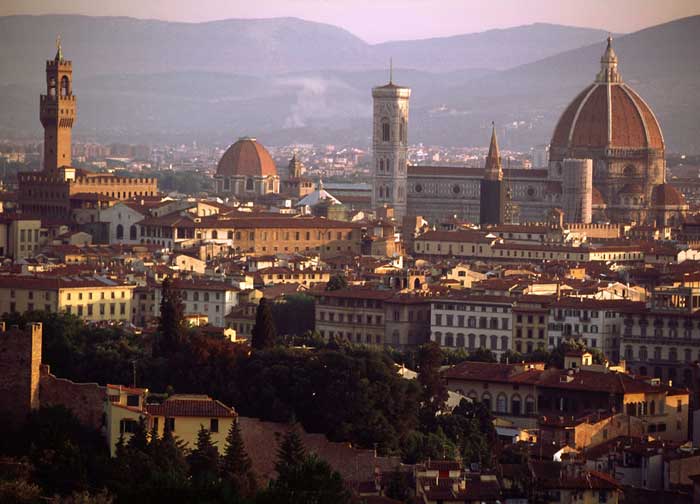 |
Florence, panoramic vierw from Piazza Michelangelo
|
| |
Piazza Michelangelo is on a hill on the south bank of the Arno River, just east of the center of Florence, and offers a stunning view of the city.
Piazzale Michelangelo is a famous square with a magnificent panoramic view of Florence, Italy, and is a popular tourist destination in the Oltrarno district of the city.
The view from this observation point overlooking the city is justly famous and has been reproduced on countless postcards and snapshots over the years.
It was built in 1869 and designed by architect Giuseppe Poggi on a hill just south of the historic center, on completion of retraining of the left bank of the shore. From that fact, Florence was the capital of Italy and the whole city was involved in an urban renewal, the so-called rehabilitation, or the rebirth of the city middle class: they were created lungarni; on the right bank, instead of the fourteenth-century walls were open the avenues of the ring of a boulevard, on the left bank was traced, wind on the hill of San Miniato, the Viale dei Colli, a street tree overview 8 kilometers long, at whose climax the square was built as a terrace with a panoramic view inside the city. The chronicle of the early construction of the company has been described in detail by the Italian journalist Peter Ferrigno (known under the name of Yorick) that does not fail to report as a part of Florence is dispiacesse "for the excessive spending of the construction.
Piazzale Michelangelo, dedicated to the great Renaissance sculptor Michelangelo, has copies of some of his works found elsewhere in Florence: the David and the four allegories of the Medici Chapel of San Lorenzo. These copies are made of bronze, while the originals are all in white marble. The monument was brought up by nine pairs of oxen on 25 June 1873.
Poggi designed the loggia in the neoclassical style that dominates the whole terrace, which today houses a panoramic restaurant. Originally it was supposed to house a museum of works by Michelangelo, ever. In the wall of the balcony, under the loggia, an epigraph is a banner characters reminiscent of his work: Florentine architect Giuseppe Poggi turn around here is his monument MCMXI.
The panorama encompasses the heart of Florence from Forte Belvedere to Santa Croce lungarni through the bridges crossing the Arno, including the Ponte Vecchio, and the Duomo, Palazzo Vecchio, the Bargello and the octagonal bell tower of the Badia Fiorentina, without forgetting opposed to the hills north of the city with the center and Settignano Fiesole.
The square can be accessed by car along the tree-lined Viale Michelangelo, constructed at the same time, or by walking the stairs going up the ramps of the monumental Piazza Poggi Poggi in the district of San Niccolò.
|
|
|
|
![]()
![]()
![]()
![]()
![]()

